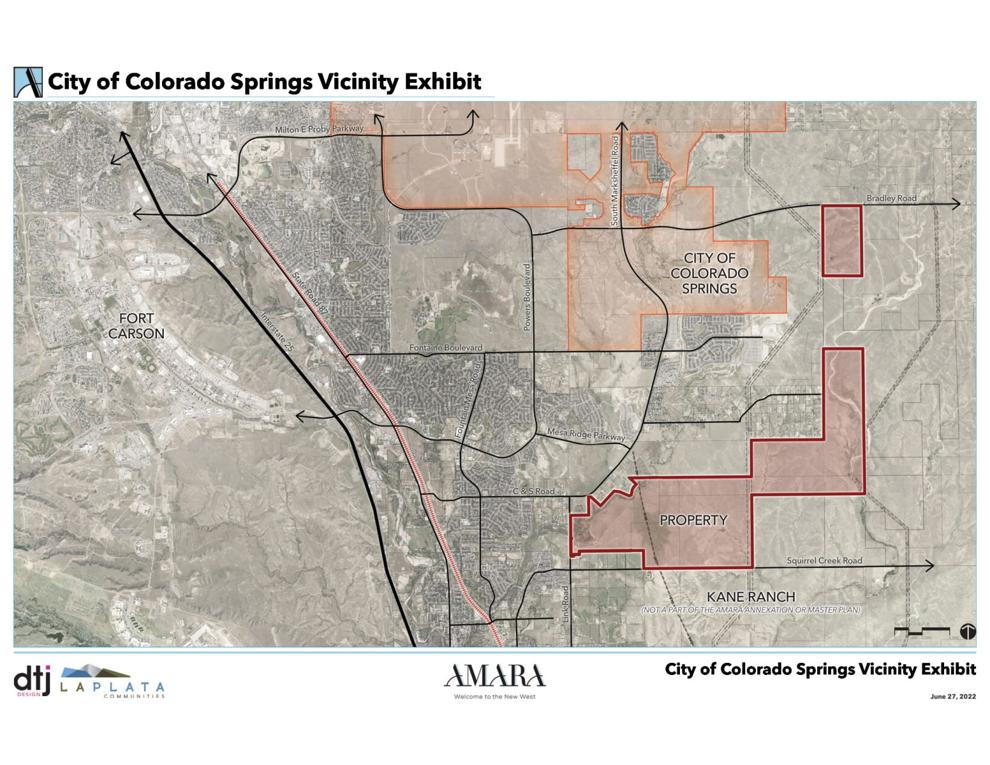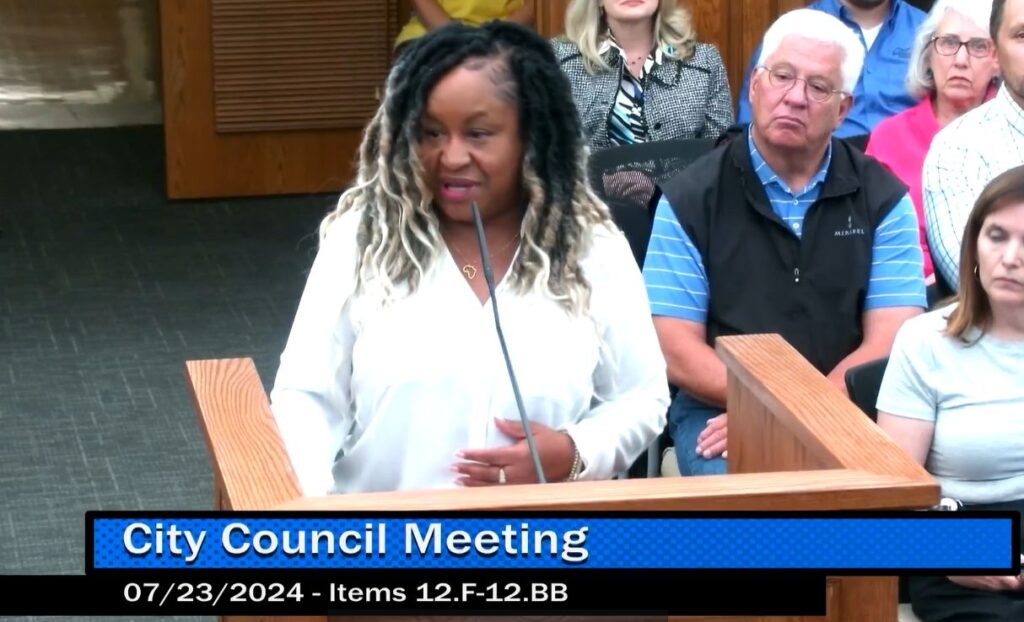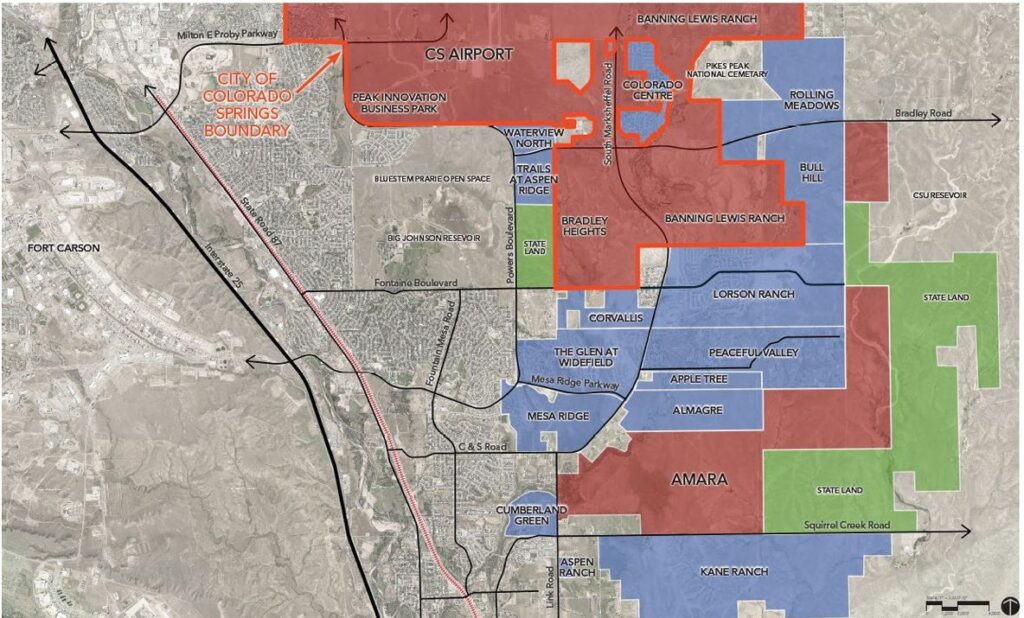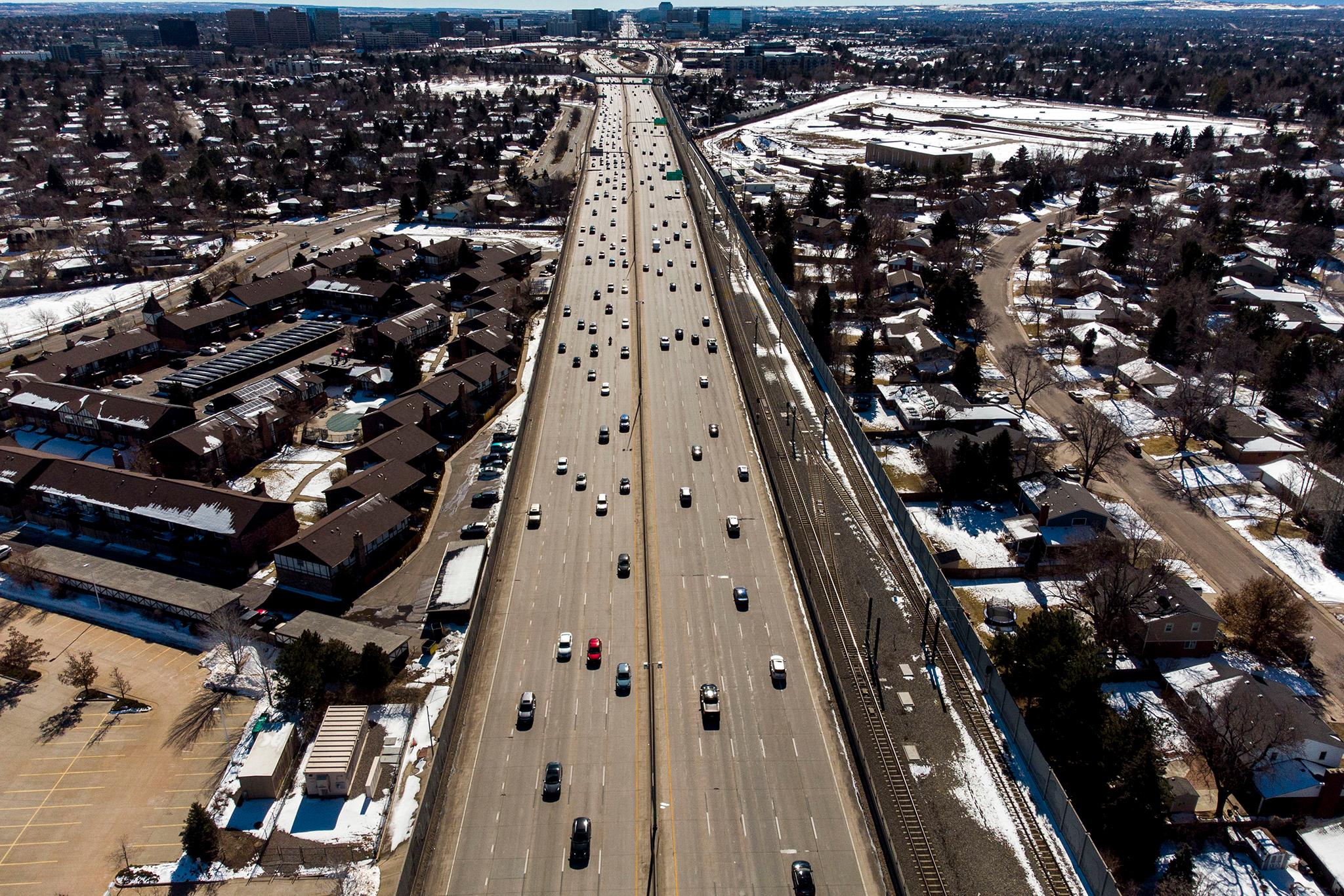
After more than seven hours of presentations, public comments and deliberation on Tuesday, Colorado Springs City Council narrowly voted to allow a proposed annexation of land southeast of the city, known as Amara, to move forward.
If it gets final approval at a future meeting, the development would cover nearly 3,200 acres with a projected build out of 9,500 residential units, 2 million square feet of commercial space, as well as parks and trails, space for schools and other services.
The proposed annexation is up to two miles away from the current city limits of Colorado Springs
The property is not currently contiguous to the city limits, which affects what's possible in terms of annexation. So the developer, La Plata Communities, last year proposed a so-called flagpole annexation. This means that the annexation would follow the Bradley Road right-of-way east and then use dozens of smaller adjacent parcels to connect south to the main development area on land bordering Fountain. This serves as a way to connect the proposed annexation to current city limits.

“This type of growth occurs with cities across the nation all the time, including Colorado Springs,” La Plata representative Cody Humphrey said during his presentation this week. “It's a shortsighted approach to growth to consider Amara as an island way out there, when past history of growth in Colorado Springs has examples like (Northgate, the U.S. Air Force Academy Visitor Center, and others). Annexations like Amara, even flagpole annexations, are a means by which future growth can be anticipated and planned for.”
Additionally Humphrey presented maps illustrating how the city has grown to fill in undeveloped areas over the years.
How would the Amara annexation affect Colorado Springs Utilities?
During Tuesday's hearing, staff with Colorado Springs Utilities said the project could adversely affect rate payer costs, other infrastructure projects and the utility's debt credit rating. The city utility’s chief systems planning and projects officer, Lisa Barbato, said they already have a large capital lift and they’ll be adding about $3 billion for other projects already in the capital plan. Any development of utilities infrastructure for Amara would be in addition to that.
“We have a very aggressive five-year outlook with our finances, due to all the regulatory, growth, and reliability projects that we have,” she said. “And so what is really challenging about this annexation is that it's really the timing of this annexation and the cost associated with developing this area.”
Base rates on customer’s utility bills typically help fund planned capital improvements, but because of those projects Barbato said it's likely an extra fee called a rider would appear on rate payer bills to help pay for the cost of the Amara infrastructure. She estimated that the average residential customer throughout the city would pay an additional $8.29 per month for the first year on top of other potential base rate increases. Barbato said she expected that amount would decrease after that, and would fluctuate over an 11-year period.
In terms of water, Barbato said there is currently enough supply to serve Amara and meet the requirements of the water service extension ordinance approved last year that affects annexations. But she also expressed concerns regarding future costs and availability of water.
Former city councilor and retired Colorado Springs Utilities staffer Margaret Radford was among several dozen people on hand to comment. She spoke in opposition to the project.
“City staff aren't allowed to tell you no. Have you noticed their job is to make it work no matter what you decide,” she said, directing her comments to the council. “If my staff at Utilities told me that my future bonding capacity was at risk, it would make my blood run cold.”
As someone who said she was deeply involved in making the Southern Delivery (water) System happen, which pipes water from Lake Pueblo to Colorado Springs, she also said she’d be concerned about the future availability of water.
“Acre feet of water don't grow on trees. We can't be sure that we will ever get more acre feet (of water) for this community,” Radford said.
Fountain would be Amara’s nextdoor neighbor
City of Fountain Mayor Sharon Thompson also spoke during the hearing. A few years ago La Plata Communities was in talks with the City of Fountain about annexation, but the two couldn't reach an agreement due to water concerns.
Thompson said they support the project, but said the annexation and development of Amara requires better collaboration and communication between the two cities, noting that she’s been disappointed by the low level of interaction by Colorado Springs representatives so far.
“There needs to be regional cooperation to account for the public safety and infrastructure, roads and stormwater and the impact of the City of Fountain in the entire Fountain Valley,” she said.
Utilities staffers have collaborated with them, according to Thompson, but other departments have seldomly met with them to address concerns about stormwater management and existing or proposed roads in Fountain and the region that will be affected by the Amara development. She said she's concerned that the proposed annexation agreement with Colorado Springs may presume communications and future plans that haven’t occurred.
“Through all the correspondence back and forth, it didn't really address any of our concerns and lacked any real solutions or substance,” she said. “We don't need to think out of the box on this development and how we're all going to work together on it. We just need to get rid of the box. Let's invent a new way to work regionally on this and figure out how to get it done.”
Several council members asked questions and responded to her. “We are going to look at development plans as they come to us and before we approve them, I want your input too,” councilor Dave Donelson said. “So I think we can work together.”
There was plenty of participation during the public hearing-starting with those in favor of the project
Many people spoke out against the project during a town hall meeting last fall with concerns about water, emergency response times and more.
But the majority of those who spoke during the public comment period Tuesday were there to support the project, largely because it could help address the shortage of housing in the region.
“For the last 30 years, the city has continued to grow further and further to the north, missing our soldiers and airmen to the south and southeast of our city,” said Donna Nelson of Fountain, Chief Development Officer for the Pikes Peak State College Foundation and military veteran. “I don't know how much longer our soldiers should have to wait to get some nice new affordable housing in a beautiful community like the ones that are developed up north.”
Her comments aligned with others who said the need for attainably priced housing for service members working at military bases in the area is critical. Other supporters spoke about the need for housing for teachers and for more childcare services in the Pikes Peak region.
The project master plan calls for different types of housing varying in cost and density. La Plata’s Humphrey said they plan to ensure that at least seven percent of the housing–or 665 homes– is affordable to people or earn 80 percent of the area median income.

Other homes will be sold at market rates. In the initial phase home costs are projected to start in the high $300,000s and go up to $685,000.
Former city councilors Bill Murray and Tom Strand also commented in favor of the project, echoing concerns about affordable housing for military personnel.
“If you've got a better plan than Amara to take care of them on the south part of our city, God bless you, implement it,” Strand said. “But they need you. It's tens of thousands of people coming in here and many of them in their 20s and 30s, so please take a look at that.”
Murray encouraged council to consider additional ideas like building an expressway to the interstate that would help connect the project to the military bases, homeowner’s association fees to cover police and fire services, and including requirements for sustainable practices like solar energy and xeriscaping.
“Reflecting on past missed and wasted opportunities reminds me of the ghost in (actor) Bill Murray’s ‘Scrooged’,” he said. “Consider me of the ‘Ghost of Christmas Past’ reflecting on past missed and wasted opportunities. It's important for you to focus on the broader vision, not just the immediate details.”
Opposition to the project came from both community members and former government officials
Meantime a recent guest opinion column in the Gazette titled “Annexation of Amara stands to hurt our community” was penned by former mayors John Suthers and Mary Lou Makepeace; former Colorado Springs City Council President Scott Hente; former Vice Mayor Richard Skorman and former Council members Margaret Radford and Val Snider.
It called Amara a "shoe-horn annexation" and labeled it the “worst kind of sprawl.” The authors point to the additional costs and burden on the city’s infrastructure and services and said, “the city’s annexation policies were never meant for this kind of annexation.”
The developer on Tuesday noted inaccuracies in the piece, including an overstatement of the cost of the rider and an exaggeration of the projected population of the annexation.
Cattle rancher Maggie Hannah, from southeast of Fountain, also opposes the project. “It does feel a bit like David and Goliath here,” she said. “Farmland, ranchland and open space are critical to our ability to produce food, fiber, energy and ensure our national security. They provide the basis for functional and intact wildlife habitat. They offer carbon sequestration, they protect water quality and they define much of the quality of life we all enjoy here.”
She also talked about diminishing water resources, as did Bent County farmer and general manager of the Lower Arkansas Water Conservancy District Jack Goble.
“I've traveled about three hours today to respectfully ask you to consider the impact that this and other developments like it have on your neighbors in the Lower Arkansas River Valley,” Goble said.
Residents of the Peaceful Valley Ranch community near the proposed Amara project said they hadn’t been contacted by the developers and were concerned about a variety of issues, including their right to safely shoot firearms on their property in the unincorporated county adjacent to the project.

How the decision landed
Mayor Yemi Mobolade was not present at the meeting, but at a media briefing before the hearing, he said one of his jobs is balancing "the need to grow with how we grow."
“It has to be done through a fair, transparent and democratic process because it's part of what makes America so great," he said. "The mayor single-handedly doesn't have the ability to pick winners and losers. I shouldn't. You don't want me to have that much power… I trust the process and I believe at the end of the day, my fellow council members will make the right decision on (Amara).”
Councilor Nancy Henjum, who voted against the project, described it as one of the most consequential decisions she’s made during her time on council.
“What strikes me here is that there are two perspectives here who firmly believe that their position is doing the right thing,” she said. “This is an incredible project. It is a beautifully planned community. I just don't think it's in the right place at the right time….we have land to be developed that is already in the city. Our promise and our responsibility is to respond to the people who live here now who are part of the city now.”
At-Large councilor David Leinweber, who voted for the project's approval, said smart growth takes effort and often risk. “Taking a risk on balancing the table a little bit between North and South (Colorado Springs) I think is an awesome opportunity,” he said.
The council was charged with considering 48 items including both ordinances and resolutions covering the project’s annexation eligibility, master plan and zoning.
They narrowly approved the first item related to the project on a 5 to 4 vote. Councilors Randy Helms, Lynette Crow-Iverson, Mike O’Malley and Henjum cast no votes, while Yolanda Avila, Michelle Talarico, Dave Donelson, Brian Risley and Leinweber voted yes.
After that, Helms cast yes votes on the other 47 items that are part of the annexation plan, so the votes were 6 to 3 in favor.
A second reading of the ordinances related to the annexation is slated for Aug. 13.
Additionally, the approved zoning is agricultural, so the developer will have to come before the board again in the future for new zoning as the project unfolds.
- Colorado Springs considers controversial annexation of thousands of acres
- Controversial Colorado Springs water service extension ordinance moves forward
- Colorado Springs planning and neighborhood services director resigns after more than a decade on the job
- Three things about Colorado Springs' growth that we're watching this week
- How and where Colorado Springs should grow its physical boundaries is on the drawing board with AnnexCOS









